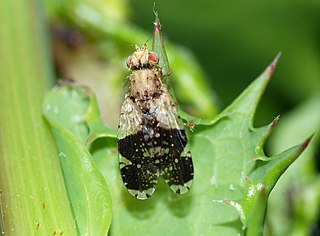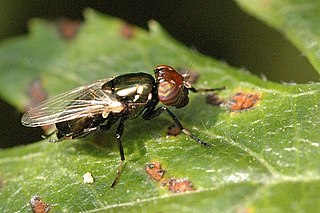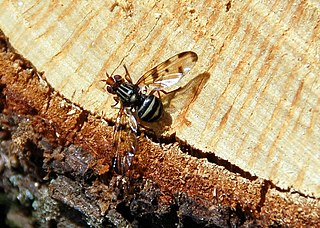
A midge is any small fly, including species in several families of non-mosquito Nematoceran Diptera. Midges are found on practically every land area outside permanently arid deserts and the frigid zones. Some midges, such as many Phlebotominae and Simuliidae, are vectors of various diseases. Many others play useful roles as prey items for insectivores, such as various frogs and swallows. Others are important as detritivores, and form part of various nutrient cycles. The habits of midges vary greatly from species to species, though within any particular family, midges commonly have similar ecological roles.

The Ulidiidae or picture-winged flies are a large and diverse cosmopolitan family of flies (Diptera), and as in related families, most species are herbivorous or detritivorous. They are often known as picture-winged flies, along with members of other families in the superfamily Tephritoidea that have patterns of bands or spots on the wings. Some species share with the Tephritidae an unusual elongated posteroapical projection of the anal cell in the wing, but can be differentiated by the smoothly curving subcostal vein. Two species, Tetanops myopaeformis and Euxesta stigmatias, are agricultural pests.

The Lauxaniidae are a family of acalyptrate flies. They generally are small flies with large compound eyes that often are brightly coloured in life, sometimes with characteristic horizontal stripes, such as in Cestrotus species. Many species have variegated patterns on their wings, but in contrast they generally do not have variegated bodies, except for genera such as Cestrotus, whose camouflage mimics lichens or the texture of granitic rocks.

Dolichopus is a large cosmopolitan genus of flies in the family Dolichopodidae. Adults are small flies, typically less than 8 mm in length. Nearly all species are metallic greenish-blue to greenish-bronze. It is the largest genus of Dolichopodidae with more than 600 species worldwide.

Tephritis is a genus of flies. It contains around 170 described species, making it the sixth largest genus in the family Tephritidae. Many more undescribed species are known from specimen collections. Tephritis occur throughout much of the world, but most are Palearctic. They can be found in a wide range of climate types, from hot semidesert to tundra. Most species inhabit the inflorescences of plants from several tribes in the family Asteraceae, and a few species cause galls to form.

Dorycera is a genus of picture-winged flies in the family Ulidiidae.

Physiphora is a genus of flies in the family Ulidiidae, containing over 30 species worldwide.

Tritoxa is a genus of picture-winged flies in the family Ulidiidae.
Tritoxa cuneata is a species of picture-winged fly in the genus Tritoxa of the family Ulidiidae.
Tritoxa pollinosa is a species of picture-winged fly in the genus Tritoxa of the family Ulidiidae.
Tritoxa ra is a species of picture-winged fly in the genus Tritoxa of the family Ulidiidae.

Tritoxa flexa is a species of picture-winged fly in the genus Tritoxa of the family Ulidiidae.

Herina is a genus of flies in the family Ulidiidae. It is possibly the largest genus in the family.
Timia is a genus of flies in the family Ulidiidae, which is difficult to separate from the genus Ulidia.

Otitinae is the name of a subfamily of flies in the family Ulidiidae. It was formerly the Otitidae. Like the Ulidiinae, most species are herbivorous or saprophagous. Most species share with the Tephritidae an unusual elongated projection of the anal cell in the wing, but can be differentiated by the smoothly curving subcostal vein. Most are dull gray to shiny brown or black flies with vein R1 setulose or, in a few cases, bare.
Diogmites missouriensis is a species of robber flies in the family Asilidae.
Diogmites texanus is a species of robber flies in the family Asilidae.

Cephaliini is a tribe of picture-winged flies in the family Ulidiidae.
Tritoxa californica is a species of picture-winged fly in the genus Tritoxa of the family Ulidiidae.
Tritoxa decipiens is a species of picture-winged fly in the genus Tritoxa of the family Ulidiidae.











